Being a bartender can be great fun. You meet interesting - often cheerful- people, can get up late, and have a chat while working. But once you take a closer look, there's a lot more to it. Everyone who worked in hospitality, no matter if it's behind a bar, as a waitress or waiter, receptionist, you name it, knows it is not all sunshine and rainbows. And it's far from being easy-going.
While you definitely can have a good time working in a bar, it can be very stressful. When it's busy, you can't just take a break - sometimes not even to go to the bathroom because not every guest is understanding and patient. And if you consider relieving a bit of that stress with the occasional drink for yourself, keep in mind that it is not always allowed to drink during working hours behind the bar.
On top of that, it's not just pouring juice, mixing some spirits, or drawing a beer. That's why you can't just decide to apply as a bartender without proper training or decent experience. And often needed certifications or proof of successfully completed bartender courses is required.
To become a master mixologist, you need to educate yourself on how to mix drinks. Plus, you need to learn and optimize your recipes, balance out flavors, and many more things. And that's still only one part of the job. You also have to make sure you treat your customers well, have a chat with them, realize when it's time to cut them off, et cetera, et cetera.
According to the Bureau of Labor Statistics BLS, the average annual salary a bartender earns is $24,960. That equals about USD12.00 per hour for a 40h work week. Numbers for top earners are indicated at about $40,000, which makes roughly $19.34 per hour.
- Due to the pandemic, the hourly wage dropped from USD12.30 to USD12, so hopefully, the industry will recover quickly and average wages will increase again.
At first glance, this might not sound super appealing to some. But those are the official numbers only, don't let them fool you. The BLS only tracks what's on the paycheck. It has no way to get insight on tips a bartender gets. And tips are the thing that can lift your salary to $100,000 per year and higher.
So yes, being a bartender can be quite lucrative. Even more, if you're experienced and work at the right place. Busy nightclubs, trendy bars, and fancy, elite places with many customers are the best chance to reach those high tips. As everyone knows, these jobs are highly competitive. So you have to have some good references to land a job like this.
Many barkeepers around the world learn everything while working in a bar. They start at the very bottom and work their way up. Learning by doing is absolutely crucial in this field, and you can't start early enough to learn everything you need to know. Either learn at home, work as a barback to learn from pros, or take a course.
There are so many technical things to educate yourself on, like a pretty garnish, handling a shaker, pouring a drink without making a mess, etc. Not to mention the show parts like throwing bottles or mastering the art of creating your own cocktail with your signature flavor. You definitely won't master them right from the beginning.
As most places require prior knowledge and experience if you want to start as a barkeeper, it makes sense to consider taking a course to learn the basics. There you will learn how to use the tools and how to mix your drinks fast and efficiently. You can also acquire these skills as a barback without taking courses, but it speeds things up when you take a course upfront. That way, the learning curve on the job will be much, much faster.
First and foremost I believe, it is the best way to learn the bartending basics is through a bartender course. You'll learn all the basics to mix great cocktails: different spirits, measuring ingredients, the importance of ice, and so on.
You will also learn a lot about your bar tools and how to handle them. For example, how you open a cocktail shaker when it's stuck. There are many different courses on the market, so make sure you choose one from a reliable source.
It's a definite "yes you sure can" from me. Online bartending courses are getting more and more popular. In my opinion, it's a great choice if you really want to get into this field and have little to no experience, especially if you don't have the time or the financial resources to do a course in person.
When attending an online course, you can set the pace and learn all the little things about creating delicious cocktails. Learn how to cut fruits, press juice, strain drinks, open & close shakers, and much more. And, of course, you need to stock up on some essential cocktail ingredients for your home bar.
Generally, I would say yes. There are some bad ones for sure. And also those that are terribly overpriced, but there are many good courses out there. If you're at the beginning of your bartending career and take this seriously, an online class might offer the best value for money.
The prices are mostly reasonable, and the course material is usually good. You'll be able to learn almost everything you need to know to become a great bartender. And once you know the theory, it's all about practice.
Cocktail shakers usually are easy to use. Especially Boston Shakers and Tin-Tin Shakers because they only have two pieces. However, separating a cocktail shaker can be tricky.
It might happen from time to time that your shaker is stuck, and you need to figure out how to open it. I know how frustrating the situation is, sometimes even awkward when you plan to play it cool in front of your friends.
But honestly, it is just business as usual when shaking cocktails, and it happens to the best.
So let's see how you can open your shaker, why this actually happens, and what you can do to prevent your shaker cups from getting stuck in the first place.
If you close your shaker correctly, it will be a lot easier to open it again after shaking your cocktail.
First, put the large shaker cup on the table. Fill it with ice and then your ingredients. Then add the smaller shaker tin or cup on top. Make sure that both form a straight line on one side (see picture).
Once your shaker cups are in place, give the upper cup a decent nudge to vacuum-seal your shaker. Now you're good to go and can shake your cocktail.

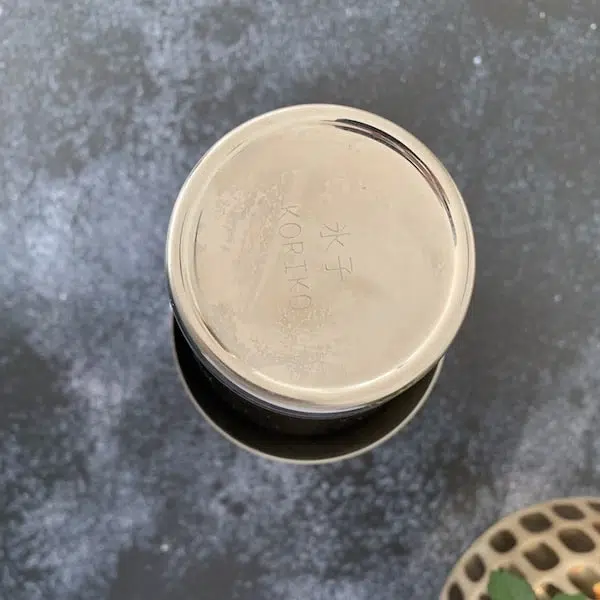
A Boston shaker consists of a tin shaker cup and a shaker glass. I've seen the glass crack more than once when someone tried to open it with too much force. So make sure to handle your shaker carefully when preparing your cocktail creations.
In the following, I'll assume you're right-handed. If you are left-handed, do everything the other way around:
Put the shaker on a table, tin shaker down. Hold the tin shaker part in your left hand and gently tap the shaker with the heel of your right hand. You want to aim for the area where the glass meets the metal to break the vacuum seal.
Turn the shaker so that the "line" faces you, then tap the side with the heel of your hand. That means, at a 90-degree angle to the position of said line.
If the shaker was closed accurately, forming a straight line from metal to the glass (see section above), opening it is relatively easy now.
If you haven't closed the shaker correctly, it will be more difficult to open it. In this case, try rotating the shaker a bit with every tap to find the spot where you can break the vacuum seal.
For a metal shaker, also called Tin-Tin shaker, it's the same procedure as for a Boston Shaker and the same technique described above applies.
Here you have the advantage that you do not need to be as careful because it's almost impossible to break a metal shaker. That, in turn, helps to break the seal faster.
On the downside, metal shakers tend to get stuck more often than Boston shakers. You want to know why? Continue reading for the answer.
There is more than one reason why a shaker gets stuck.
One might be the use of sticky ingredients in your cocktail mixture that "glue" the shaker together. It's also possible that you closed it inaccurately or used too much force to seal it.
Yet, in most cases, the reason is the ice: To shake your cocktail, you put plenty of ice in your cocktail shaker.
The metal, usually stainless steel, is a super good conductor. That means frost on the outside of your shaker tins. When stainless steel gets cold, it contracts, and you end up with a stuck cocktail shaker.
You see, there's no malpractice on your end. It's simple physics that leads to stuck cocktail shakers.
As mentioned, the amount of ice used in a cocktail shaker and the fact that stainless steel is such a good conductor lead to two things.
First, the chilled inside of the shaker causes the air pressure to go down. That in combination with some more complex reactions leads to a vacuum seal of your cocktail shaker.
Second, while shaking your cocktail, the outside of the shaker gets so cold that it contracts and further tightens the seal. Usually, around 14 pounds of force are needed to break it.
But that's only in an ideal world. In reality, there may be cases where you need a lot more force to open a shaker.
Now you know how to open a stuck cocktail shaker, but what to do if nothing helps?
If you still can't open your shaker and there's nobody there to help, there's one more thing you can do. Unfortunately, it means the cocktail you or your guests are looking forward to so much is gone:
Wait until the ice melts and the temperature of your shaker is back to normal, then it should be easy to open. -The drink is lost, but you don't need to worry about your shaker.
It is not always up to the barkeepers themselves if drinking during the job is okay. Sometimes the management of a bar strictly prohibits drinking on the job. That situation is pretty much straightforward.
Yet, in some places, bar managers encourage their staff to drink with guests to lift their mood, make them wanting to drink more and, as a result, spend more money in the bar.
Further, apart from personal reservations one might have, you should know that drinking during the job is illegal in certain countries or states if you're responsible for serving (drinks) to guests.
So when working in a bar where this is common to have a drink during your shift, you want to make sure you know the law.
Some do, some don't. I know many bartenders who do drink shots with guests or the bar crew - Generally, this is more common (and sometimes more frequent) than you might think.
However, for obvious reasons, it is less common in high-end bars as guests there usually expect the staff to act professionally.
As a rule of thumb, it is safe to say: the more laid-back the location (country, state & bar), the more often you'll see bartenders drinking during their shifts.
Let's take a closer look at the legal part. It isn't possible to cover every country and every state's laws in this article. But overall, there are more countries where it's perfectly fine for barkeepers to drink while working than those where it is not.
In saying that, always remember that you also should be of legal age to drink. In the US, you may be allowed to serve drinks at 19 years but are still not allowed to drink alcohol until you're 21. That should be common sense, but I wanted to mention it.
Little surprisingly, it is perfectly alright. In the United Kingdom, it is absolutely legitimate for a bartender to have a drink while working behind the bar.
It might not even be a problem (legally) to be drunk during your working hours. But guys, keep in mind that it's not only a question of the law. Your bar manager might not like it very much if his bar staff is out of order due to "team shots".
In Germany, it's quite common to have a drink with your barkeeper. If you're having a good time with your barkeeper, they may offer you a drink on the house, and sometimes he drinks one too.
However, many bartenders refuse to drink during their shift. Not because it's illegal but because it's more professional to not drink during shifts.
Yes, it's legal in France. It's even legal to drink wine, beer, and cider at your office job. Not everywhere these days, but there is still a large number of places allowing this.
There even was a law saying people have the right to drink during working hours, for instance, having wine during their lunch break.
So it's no surprise that barkeepers are allowed to have a drink or two while working.
To sum it up, in Europe, there is usually absolutely nothing to worry about legally. 😉
If you like drinking during working times, Australia might be your place. I don't know any other country where it's this common to have plenty of drinks while working.
I would not say this is an ultimate advantage for everyone, but it's alright legally. Bar managers often encourage their staff, in some cases even expect them, to drink to keep the crowd motivated.
Here's a short and sweet article about the first-hand experience of a bartender thereabouts.
The situation here is very different from Europe and Downunder. And because most of my readers come from the United States, I'd like to take a closer look at US laws.
I put together an overview of the different state laws. I read a ton of law documents and contacted authorities to clear up this question as much as possible. The results are listed below.
If you should find anything that doesn't sound right to you, please let me know.
There are three options: Legal, illegal, and "Legal?". I think the first two are clear. They are states where there is a written paragraph stating that it's either totally okay or illegal.
For all states having the "Legal?" option, I could not find any law prohibiting bartenders from drinking alcohol on the job. So I assume it's legal. I'll update the information regularly, so you can check again later if your state doesn't have a clear answer yet.
Also, if you have knowledge of these laws in any of the states marked "legal?", please let me know. I appreciate any feedback and am happy to update the information.
So let's see what I found out:
| State | Legal or Illegal | Notes |
| Alabama | Legal? Didn't find a law against that but look at the note. I wouldn't risk it. | "A server may be found guilty of negligence if, under the same circumstances, a reasonable person would have acted differently." |
| Alaska | Legal | "Sellers/servers may drink while on duty, but no intoxicated person may remain on the premises, so an impaired server could be arrested." |
| Arizona | Illegal | |
| Arkansas | Legal | Please check it for yourself here. |
| California | Legal | |
| Colorado | Legal, but... Can't find any law against it but you can be held responsible if something happens to one of your customers. | You may be found guilty if a „reasonable“ person would have acted differently. |
| Connecticut | Legal? | |
| Delaware | Legal? | |
| District of Columbia | Illegal | |
| Florida | Legal? | |
| Georgia | Legal, but... Didn't find a law against that but look at the note. I wouldn't risk it. | It’s possible that you may be found guilty in case a reasonable person would have acted in a different way. |
| Hawaii | Legal | Please check for yourself here. |
| Idaho | Legal | See here. |
| Illinois | Illegal | |
| Indiana | Legal, but... Didn't find a law against that but look at the note. I wouldn't risk it. | As a server you may be found guilty of negligence in case, under the exact same circumstances, another person would have acted differently. |
| Iowa | Legal, but... Didn't find a law against that but look at the note. I wouldn't risk it. | "Laws governing an intoxicated person also apply to licenses. Intoxication impairs judgement and interferes with sound business decisions. For this reason, licensees may find it a good business practice not todrink while working." (Iowa’s Alcoholic Beverage Laws and You) |
| Kansas | Legal? Can't find anything for Kansas. Also nor law against it but would not recommend drinking on the job because of possible Dram Shop Liabilities. | |
| Kentucky | Legal | See here. |
| Louisiana | Legal? Can't find a law against it. | |
| Maine | Legal? Despite Maine having some pretty special liquor laws, I could not find any law against drinking while working behind the bar. | |
| Maryland | Legal? Can't find a law against it. | |
| Massachusetts | Legal I could not find any law that prevents barkeepers from drinking. | See here. |
| Michigan | Legal But it's illegal to be intoxicated, so there's a fine line. | Check: Michigan Liquor Laws & Rules |
| Minnesota | Legal There's no state law preventing it but cities could overrule state laws. | |
| Mississippi | Legal? Nothing to be found. | |
| Missouri | Legal? Couldn't find any law prohibiting it. | |
| Montana | Legal? No Law found that's prohibiting it. | |
| Nebraska | Illegal | |
| Nevada | Legal? I could not find any law that prevents barkeepers from drinking, so it looks like it's fine. | |
| New Hampshire | Illegal | Check here. |
| New Jersey | Legal I could only find somehting that indirectly explains that drinkin on the job is fine for bartenders - But only during opening hours. | "Even employees are not permitted to consume alcoholic beverages before or after the closing hour", source |
| New Mexico | Legal? Can't find a law. | |
| New York | Illegal | |
| North Carolina | Legal? Although there are many laws regarding selling & serving alcohol there seems to be no law prohibiting barkeepers to drink during working time. | |
| North Dakota | Legal? | |
| Ohio | Illegal | |
| Oklahoma | Legal? | |
| Oregon | Legal But only a little bit of Beer, Wine or Cider | See here. |
| Pennsylvania | Illegal | Check here |
| Rhode Island | Legal? Could not find anything that prohibits this. | |
| South Carolina | Legal? | |
| South Dakota | Legal? Couldn't find any law prohibiting it. | |
| Tennessee | Legal? | |
| Texas | Illegal | |
| Utah | Legal? | |
| Vermont | Illegal | |
| Virginia | Legal? | |
| Washington | Illegal | |
| West Virginia | Legal? I couldn't find a law prohibiting bartenders to drink during shifts. | |
| Wisconsin | Legal | Please check here. |
| Wyoming | Legal? | |
| Puerto Rico | Legal |
Most likely, the Negroni recipe originated at Caffè Casoni in Florence, Italy, in 1919. A bartender working at Bar Casoni created this iconic drink in an attempt to mix a stronger version of an Americano Cocktail. The cocktail was named after the patron who ordered this boozier version - Count Camillo Negroni.
Quick facts Negroni Cocktail
The result is a strong cocktail (24% ABV) that tastes refreshingly bitter and has a rich and complex flavor profile. A drink that's celebrated for a whole week each year - the Negroni week. In contrast to the herbal and botanical flavors in the drink, the essential oils from fresh orange peel add a nice touch.
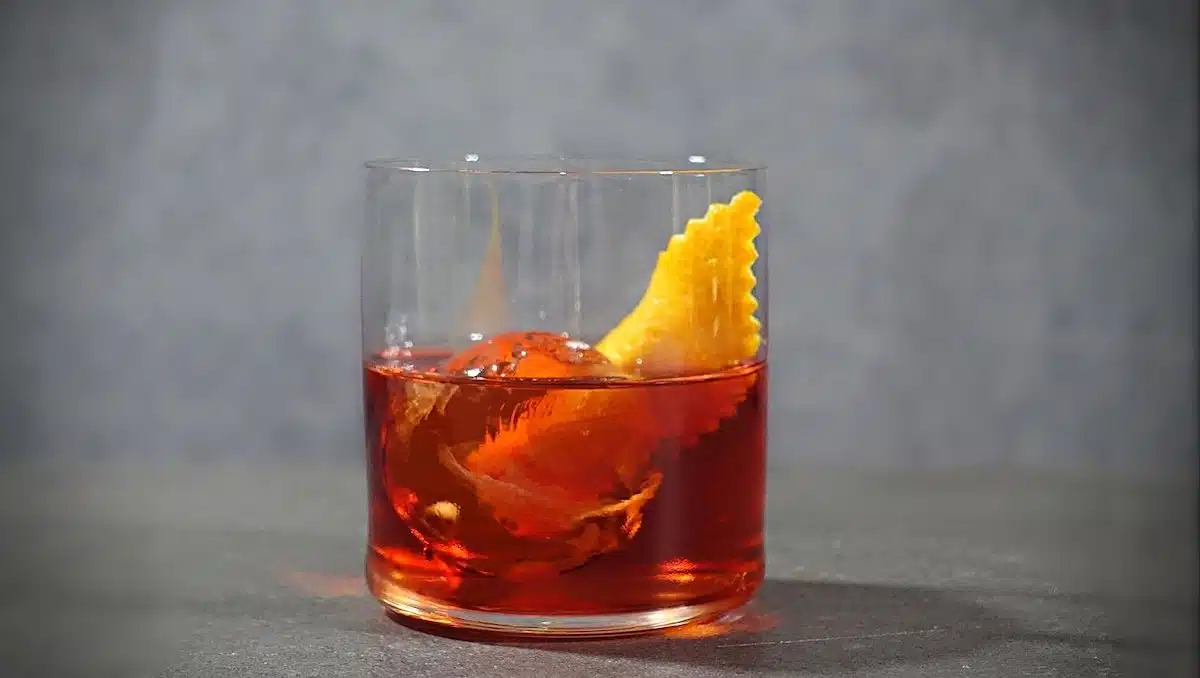
The history of the Negroni cocktail began in Florence, Italy. According to legend, Count Camilo Negroni ordered a stronger version of his favorite drink, the Americano cocktail. Bartender Fosco Scarselli did as instructed and replaced soda water with gin. Scarselli named the drink after Count Negroni to commemorate who gave him the idea.
Over the years, this story has often been doubted. Some have even tried to take credit for this invention themselves. But none of these attempts was well enough proven to finally debunk the Count Negroni tale.
And since the Negroni cocktail was first mentioned in Horace Sutton's book Footloose in Italy in 1950, it is highly unlikely that we will ever be able to say for sure what the origins of this Italian classic were.
The standard Negroni recipe consists of three ingredients. Here's a quick guide on what to look for and which products you need:
An orange peel twist is the default garnish and adds a subtle citrusy touch to the drink. In addition, some bartenders also use orange bitters to enhance the flavors in the cocktail.
If you don't have an orange at hand, just leave the drink like it is. Other citrus fruits don't work as well with the flavors of a Negroni. Diffords even names the addition of a lemon peel a "heinous crime." -We couldn't agree more.
The Negroni cocktail recipe is a perfect example of stirred cocktails. Making it is pretty straightforward. -Particularly because the recipe requires equal parts Gin, red Vermouth, and Campari.
Choosing the ideal glassware for a Negroni cocktail is a task in itself. It should be elegant, classy, and not too large. I like to serve it in either a Singel Old Fashioned glass or a Double Old Fashioned glass. This depends on the measurements I use for making the drink.
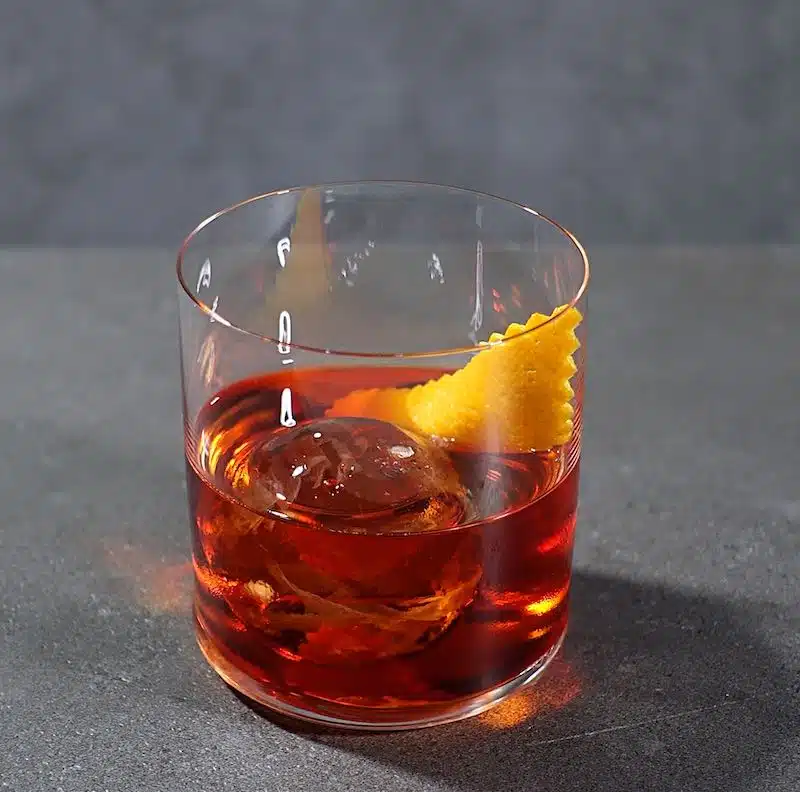
A modern phenomenon is that bartenders are increasingly using more gin in Negronis. Often they increase the gin content to 1.25 or 1.5 ounces and stick to 1 ounce for each Campari and Italian vermouth. Sometimes, however, they adjust the measurements for all three ingredients.
This is often explained by evolved palates. Increasing the gin content better keeps the dominant bittersweet taste of Campari in check. The flavor profile is more rounded and somewhat modern.
However, these nuances are only relevant for Negroni connoisseurs. If you have never tried a Negroni, start with the simple equal parts recipe. Then you can vary the amounts and ingredients to find your preferred recipe.
The easy template of this classic Italian cocktail makes it an ideal drink for experimenting. Some of these variations swap the base spirit, others add additional elements, and others again use an entirely new set of ingredients.
Here are some of the most popular Negroni riffs:
More Negroni riffs:
A cocktail pick, also called a cocktail skewer, is a bar utensil often used to spear cocktail garnishes like cocktail onions, olives, tomatoes, cherries, and citrus fruit peels. The stick is then placed on the rim of a glass to decorate a cocktail and improve its visual appearance.
It's a thin, elongated piercing tool with a decorative handle at the top. A cocktail pick can come in various sizes, ranging from 2.5 to 6 inches. The spear part is usually round, sometimes also flat-oval or angular.
These nifty utensils come in various materials like bamboo, wood, plastic, glass, stainless steel, and sterling silver.
Cocktail picks, cocktail skewers, or cocktail sticks are thin, cylindrical sticks with sharp ends to decorate cocktails. For this, bartenders spear cherries, cocktail onions, fruit peels, grapes, or tomatoes on the pick and lay it on the rim of a cocktail glass.
Cocktail picks came in different sizes, colors, materials, and shapes. Most are reusable and made of stainless steel or sterling silver, while others are intended for one-time use.
The most common way to use a cocktail pick is to garnish a Martini with olives. Olives are speared onto a cocktail pick and put on top or inside your Martini glass.
However, many other drinks and garnish types rely on cocktail picks. Apple fan garnishes, like in this Angel Face cocktail, will need a cocktail pick to fix the fan.

A combination of Maraschino cherries and citrus peels is a common combination to create a fancy garnish for an Old Fashioned cocktail. Even Bloody Mary cocktails often make use of a cocktail pick to decorate a drink with a variety of things, from bacon to pickles, tomatoes, and quail eggs.
The best ways to use a cocktail pick are:
The length of a cocktail pick can vary. Usually, it is between 2.5 and 6 inches. Standardized cocktail picks are between 4.5 - 5 inches long, including the decorative end.
The decorative item at the top is usually around 1 inch long, so the cocktail stick measures between 3.5 and 4 inches. Depending on the glass you intend to use, you might want to look for longer or shorter versions.
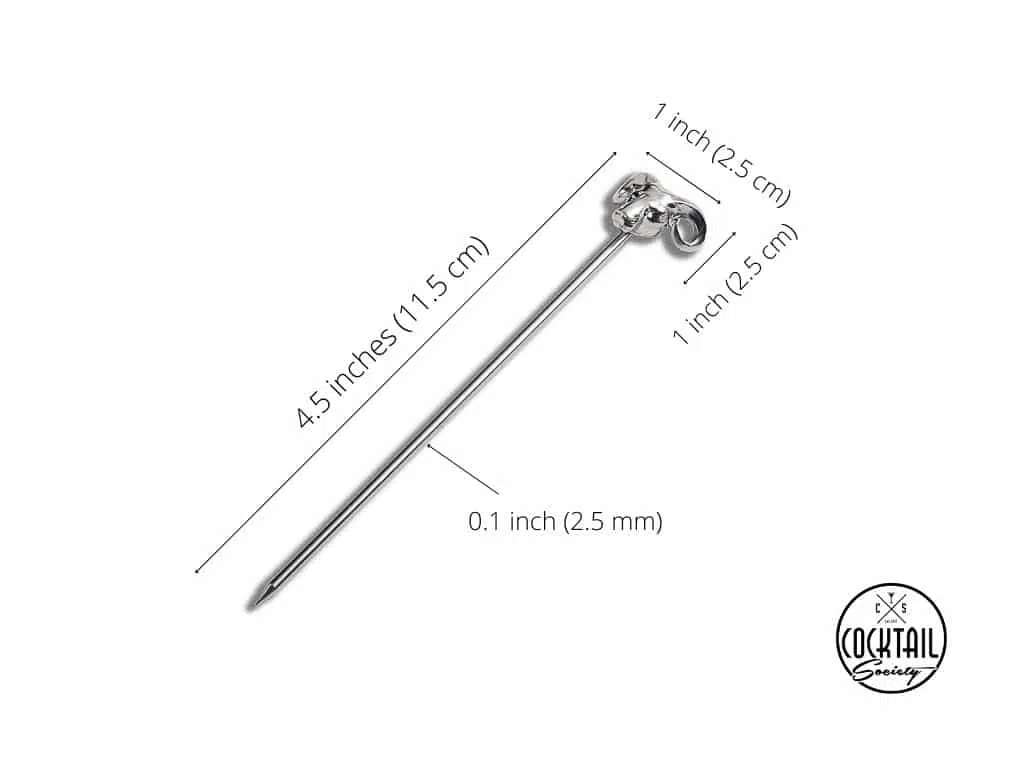
For example, if you want to position the cocktail pick on top of a glass, you should check the diameter of said glass. Always make sure the cocktail pick can comfortably sit on the rim without falling in.
If you want to stick it into a small Coupe or Martini Glass, it might make sense to use a shorter pick. And also one with an end that's more lightweight. Otherwise, it can easily tip over the rim of the glass and mess up your cocktail presentation.
Regardless if your cocktail pick is wooden, plastic, metal, or bamboo: the standard thickness is around 0,1 inch (or 2.5 mm).
That makes the cocktail stick thin enough to spear olives, cherries, or raspberries yet strong enough not to break while preparing the decoration.
Especially bamboo and plastic picks will still break sometimes. -For instance, when facing a rebellious olive. In my opinion, it's better to invest in durable stainless steel or silver picks anyway. They last longer and protect the environment.
Cocktail picks come in various materials: bamboo, wood, plastic, glass, and metal. I prefer cocktail picks with a stainless steel metal stick, while the decorative handle may be of a different material. They are reusable, easy to clean, elegant, and durable.
Most other materials are too fragile, not 100% hygienic when used more than once, or intended for one-time use only. But to give you an overview, those are your usual choices:
We talked a lot about what the ideal cocktail pick looks like, let's check out some of our recommendations. Here are the best cocktail picks to add to your bar cart.
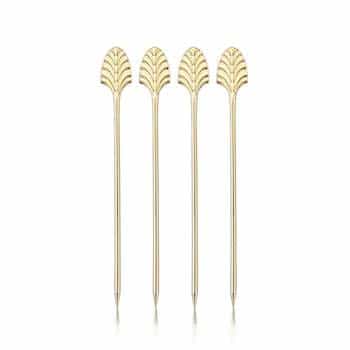
Price: $16 (4 pcs)
Pros:
Cons:
These vintage-styled cocktail skewers from Viski are one of our favorites. They're made from durable stainless steel and feel quite heavy in your hand. They add an elegant touch to your cocktails and are ideal for garnishing classic drinks like a Dry Martini or Negroni cocktail.
The golden finish is very durable, however, to prevent color-changing, make sure to always clean them by hand. Most of the time, the plating won't suffer from cleaning in a dishwasher, but in some cases, it does (with all other picks, too).
They're about 5 inches long, around 0.5 inches above average. That makes the pick suitable for a higher number of glasses.

Price: $24 (4 pcs)
Pros:
Cons:
The black and golden snake picks from Love & Victory are a great way to decorate your drinks in style. They're made from stainless steel with beautiful gold plating and a black enamel finish.
These delicate details have one downside, you must clean these beauties by hand. Otherwise, a dishwasher could harm the picks and destroy the color and finish.
They're slightly below average in size, with a heavy snake on top. That makes balancing a bit harder than usual.
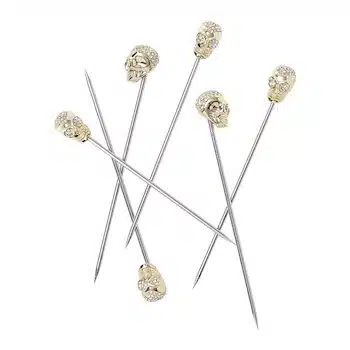
Price: $98 (6 pcs)
Pros:
Cons:
Joanna Buchanan produces some of the best cocktail picks available right now. My favorites are this badass skull picks with zinc and glass stone finish.
They're made from high-quality materials that make the picks not only look good but also very durable. The major downside is - like with all of these fancy cocktail picks - they require manual cleaning.
With 4 inches in length, the picks are on the shorter side of the spectrum.
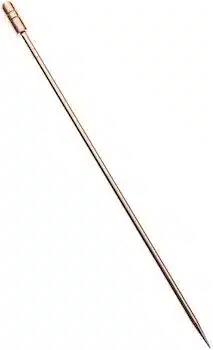
Price: $16 (12 pcs)
Pros:
Cons:
If you're looking for a more classic look, these cocktail skewers from Barfly are an excellent choice. For only $16, you get 12 classic-styled cocktail picks with delicate copper plating.
Made from stainless steel, these picks are remarkably durable and have a pleasant weight. Their elegant shape makes them easy to clean, even though, you still have to clean them manually if you're buying plated picks.
The length of these picks is 4.4 inches, an ideal length for a classic cocktail skewer. The top is also comparably light which makes balancing a lot easier.
You can get basic cocktail picks in your local supermarket. If you're looking for a more advanced design, look on Etsy or Amazon for a huge selection of picks. For custom-made, unique products check out producers like:
The sky is the limit. There are endless possibilities, but the classics are maraschino cherries, olives, raspberries, grapes, and flowers.
However, don't be afraid to be creative. Cocktail picks with the speared garnish can elevate your cocktail in a fancy way. Think about your cocktail and its ingredients to find out what could complement or enhance its flavors.
Looking at the bottle and its details, you can see already that a lot of passion goes into creating this Gin. Elephant Gin has a unique yet low-key bottle design. Writing this review, I remember how perfect I thought it was the first time I saw it almost a decade ago. It's not modern or overly fancy but made with so much attention to detail.
It starts with the unusual bottle shape sealed with a big cork and the cord around the bottleneck sealed with a lead seal. The front shows a stamp-like label.
Each batch is named after a living or former elephant. In addition, the bottom label on the front is hand-lettered by a calligrapher. The backside label is also printed on both sides, and looking through the bottle, it shows a map of Africa.
Elephant Gin is a wonderfully crafted small batch London Dry Gin inspired by African flavors. At 45%, Elephant Gin consists of 14 different botanicals. Some of these underline the African theme like Baobab, Buchu plant, African Wormwood, and Devil's Claw. Of course, there are also more classic botanicals such as juniper, ginger, pine, orange peel, and apples.
As already mentioned, the flavor profile is very African. That is because the idea for Elephant Gin came from the creators', Robin und Tessa Gerlach, travels thorugh Kenya, South Africa and Tanzania.
The Gin is crafted and distilled in copper stills just outside of the city of Hamburg in North Germany.
Here's my review of the taste, which tonic I recommend for a G&T with Elephant Gin, and some other things I find noteworthy.
The nose is initially quite heavy on juniper. Then other, more fruity and spicy notes come forward. The flavor profile of the Gin from Hamburg is quite complex and multilayered.
It carries a pleasant spiciness from juniper and pepper and African herbs like Loin’s Tail, Buchu, and Baobab. And you can also detect sweeter notes and hints of fruit and citrus. -All in all, a round and smooth tasting experience.
With 45% ABV, Elephant Gin is relatively high in alcohol. Still, because it is so well balanced, there os no overly harsh bite from the alcohol and pleasant to sip neat.
My recommended tonic water for Elephant Gin is Fever Tree Indian Tonic. Depending on the desired strength, aim for a gin to tonic ratio of 1:2 or 1:3. However, this is only my recommendation. And as everyone is different, you might as well try some of your favorite tonic waters. But as with every quality Gin, please make sure to use quality tonic water.
Yes, it is. Like most other Gins, Elephant is considered Gluten-Free. But make sure not to add any other ingredient containing Gluten to your drink.
Elephant Gin has a superb flavor profile and is a great Gin to drink. And it also helps save elephants in Africa. Already since the launch in 2013, 15% of revenue from bottle sales has been donated to the Big Life Foundation and Space for Elephants. I love the idea and support it regularly by stocking up on Elephant whenever I can.
A well-balanced Gin like Elephant needs the perfect tonic water (see recommendation above). Because it is such a complex Gin without a strongly dominant taste, you don't want to overpower it with your tonic. When it comes to the garnish, a slice of fresh apple works perfectly in an Elephant G&T.
Not long ago, Elephant launched a new addition to their Portfolio. An Orange Cocoa Gin that combines sweet and citrusy orange flavor with notes of gently roasted cocoa. If you haven't tried it yet, you should definitely give it a go.
The fruity notes of oranges combined with a hint of blood orange are a gorgeous base for a summer Gin & Tonic. I recommend trying it with Fever Tree Mediterranean Tonic water. That works really well with the orange flavors and enhances the cocoa flavor. All in all, it makes for quite a unique Gin Tonic.